Executive Summary
Norway stands at a pivotal moment in its artificial intelligence journey, positioned competitively among Nordic countries with clear ambitions to become a global AI leader by 2030. This report provides a comprehensive assessment of Norway's current AI readiness and performance as of mid-2025.
With a national AI strategy focused on strategic sectors including health, seas and oceans, public administration, energy, and mobility, Norway has demonstrated strong government commitment through significant funding allocations and institutional support. The country ranks 10th globally in AI readiness according to recent indices, with particular strength in responsible AI use where it ranks 2nd worldwide.
Key strengths include Norway's robust public sector AI adoption rate of 50%, strong private sector engagement with a business AI adoption rate of 30% (significantly above the EU average of 13.5%), and a comprehensive national strategy backed by substantial investment. The AI market in Norway is projected to reach US$1.41 billion by 2025, with the government committing at least NOK 1 billion (over €87 million) over five years to AI research.
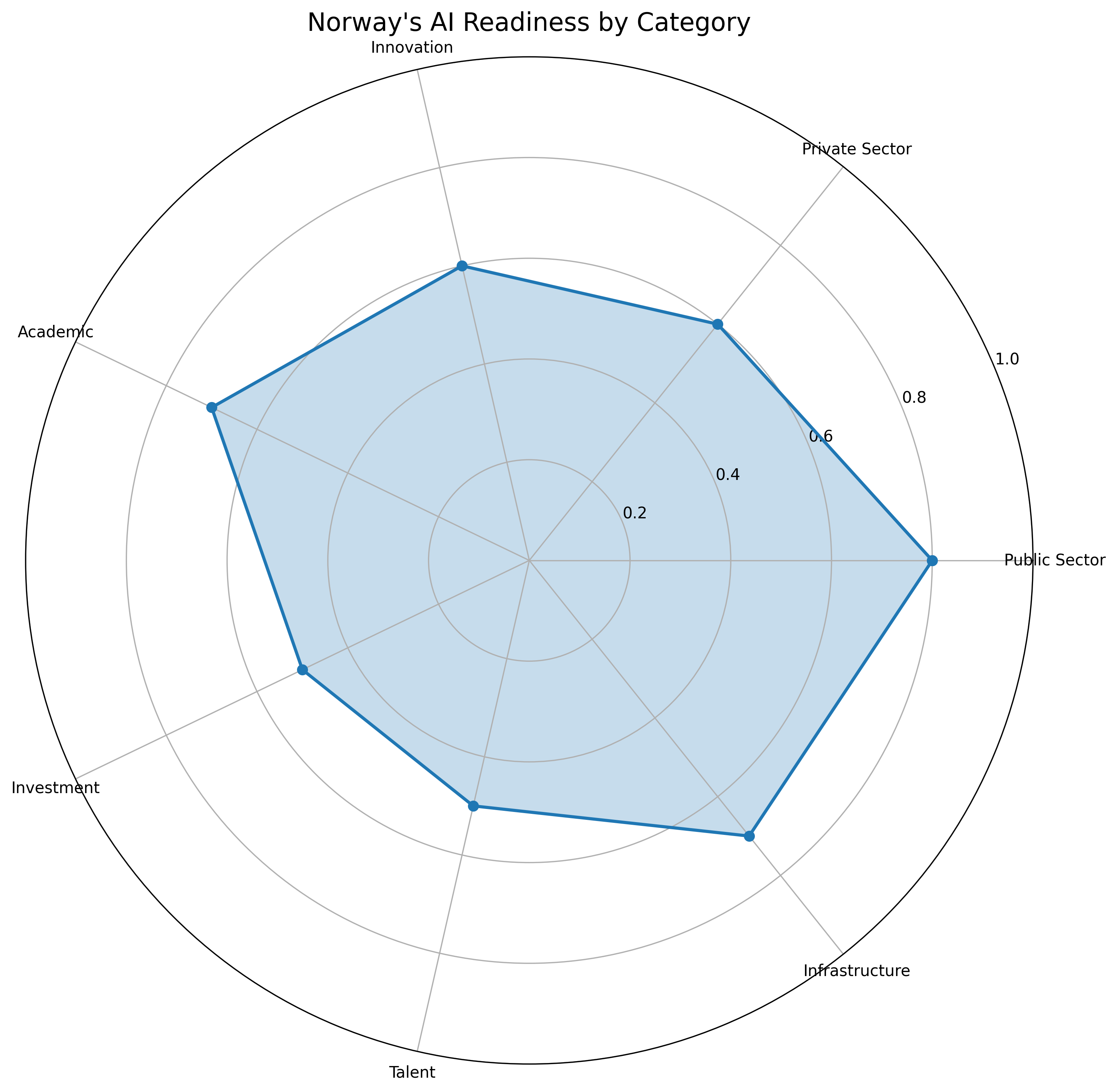
Norway's AI Readiness by Category
However, challenges remain in scaling AI adoption across all sectors, addressing talent gaps in specialized AI skills, and maintaining competitive positioning against rapidly advancing Nordic neighbors, particularly Finland and Denmark. While Norway ranks 18th globally in AI innovation, ahead of Finland (20th) and Sweden (25th), it trails behind Denmark (17th).
Looking forward, Norway's trajectory in global AI appears promising, supported by strategic investments in research centers, talent development, and digital infrastructure. The country's path to becoming the most digitalized nation by 2030 will require sustained focus on implementation of its comprehensive strategy, acceleration of private sector adoption beyond current levels, and continued development of specialized AI talent.
National AI Overview – Norway
Norway's national approach to artificial intelligence is characterized by ambitious goals, strategic focus areas, and substantial government commitment. The country has positioned AI as a cornerstone of its broader digital transformation agenda, with the explicit aim of becoming the most digitalized country in the world by 2030.
Norway's National AI Strategy and Key Initiatives
Norway's National AI Strategy for 2025 outlines a comprehensive approach to AI development and implementation. The strategy emphasizes ethical principles, respect for human rights and democracy, and focuses on education, research, innovation, ethics, and infrastructure development. It aims to position Norway as a leader in AI innovation and application, with the establishment of a national AI infrastructure by 2030.
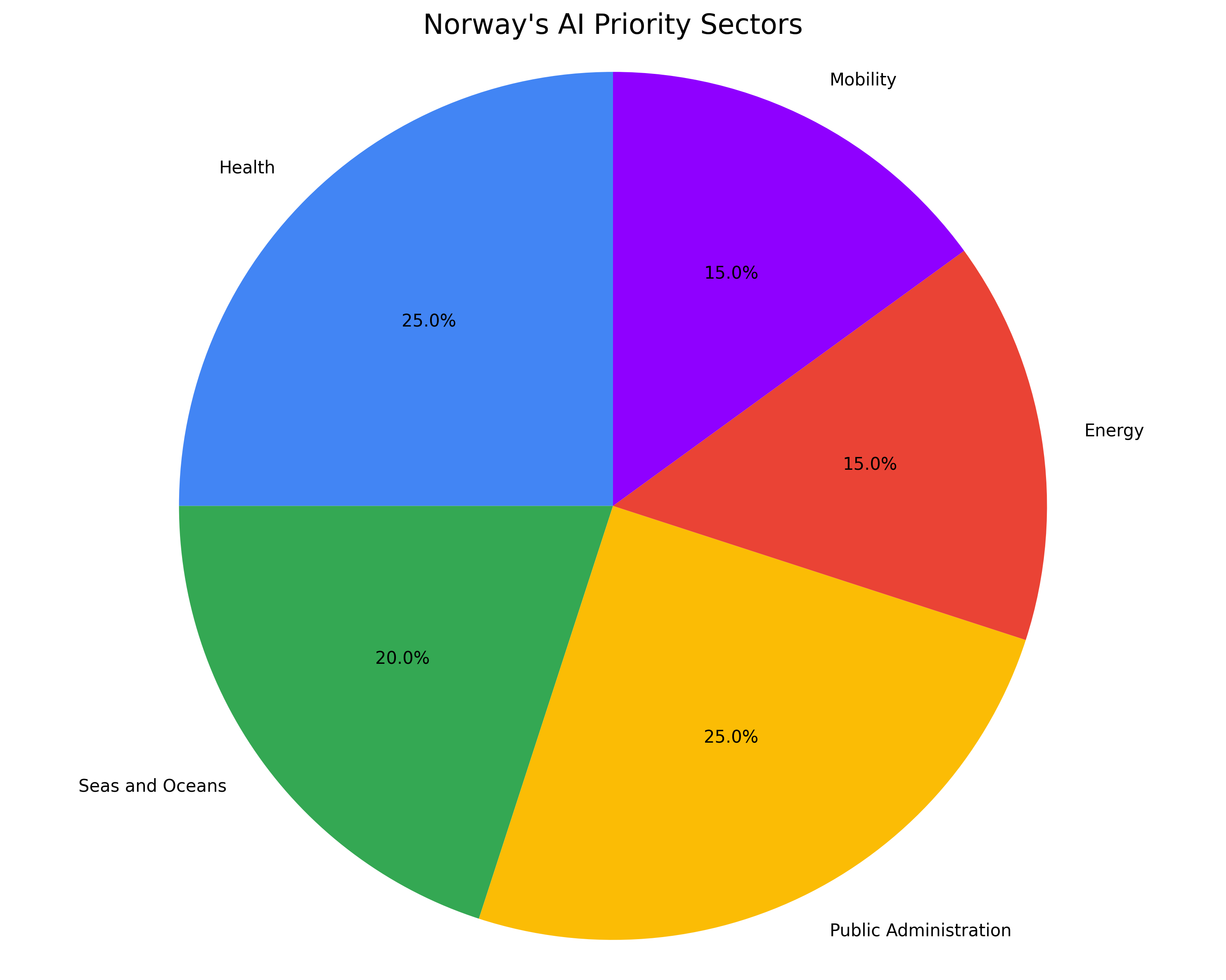
Priority AI Sectors in Norway
Government Commitment and Investment Levels
The Norwegian government has demonstrated substantial financial commitment to AI development, pledging at least NOK 1 billion (over €87 million) over five years for AI research. This includes the 'AI billion' initiative, which will fund the establishment of 4-6 new AI research centers by 2025, with each center receiving between NOK 75-200 million. Additionally, the government is developing a national supercomputer to support AI research infrastructure.
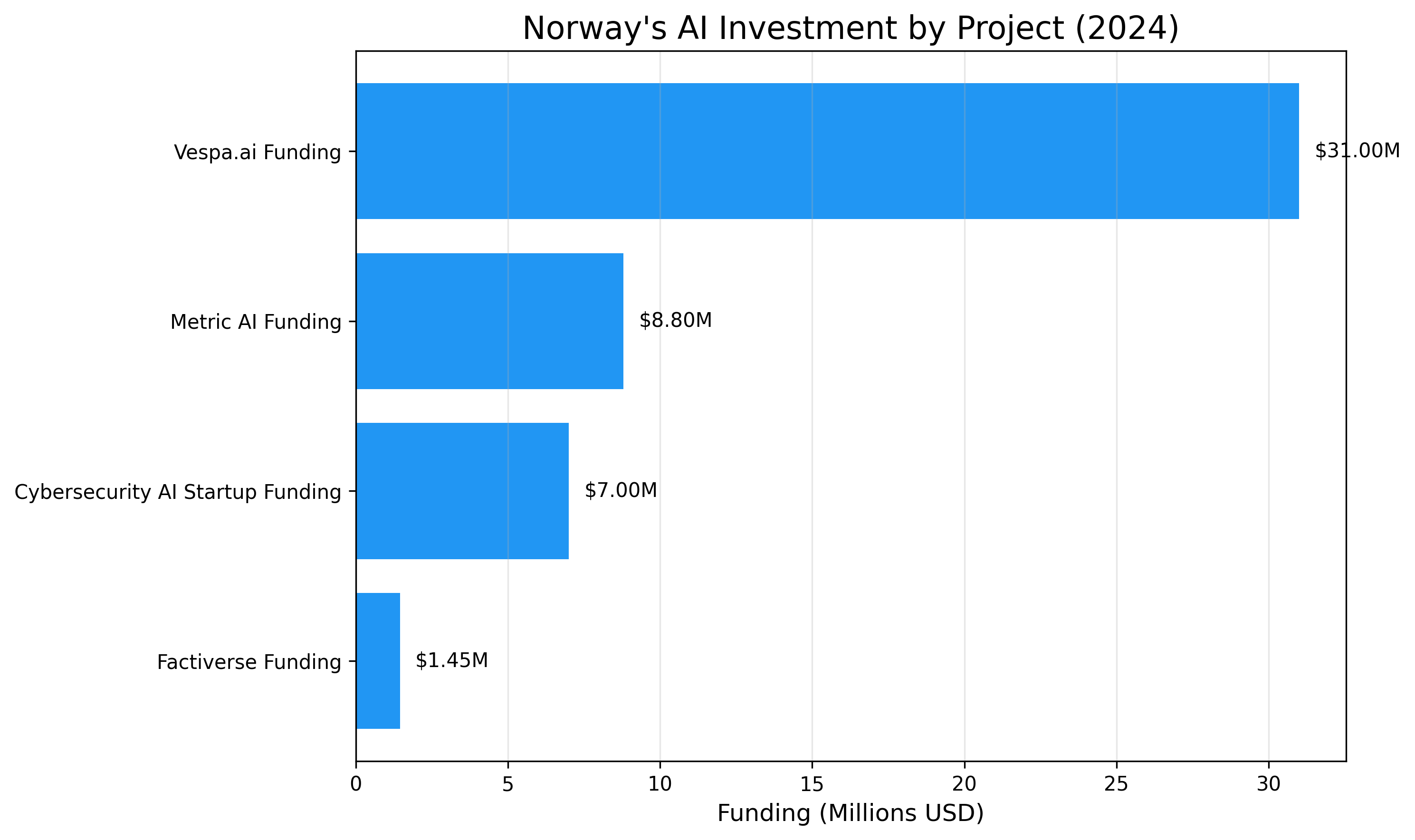
AI Investment in Norway (2024-2025)
Timeline of AI Policy Development
- 2020: Initial National Strategy for Artificial Intelligence published
- 2023: Updated AI strategy with increased focus on research infrastructure
- January 2024: Establishment of the Ministry of Digitalization and Public Governance
- 2024: Enactment of an Artificial Intelligence (AI) Act aligned with EU frameworks
- 2024-2025: Launch of the 'AI billion' initiative for research centers
- 2025: Proposed implementation of comprehensive AI Act regulations
Key Stakeholders in Norway's AI Ecosystem
Norway's AI ecosystem encompasses a diverse range of stakeholders across government, industry, academia, and civil society. Key government stakeholders include the Ministry of Digitalization and Public Governance, established in January 2024, and the Research Council of Norway, which manages significant AI research funding. In the private sector, notable players include Vespa.ai (which secured $31 million in funding), Metric AI (€8 million in funding), and various cybersecurity AI startups. Academic stakeholders include the Norwegian AI Research Consortium and the planned 4-6 new AI research centers.
Current State of AI Adoption Across Sectors
AI adoption in Norway shows significant variation across sectors. The public sector demonstrates strong adoption with a 50% AI adoption rate, with more than half of central government entities having integrated AI technologies. In contrast, private sector adoption stands at 30% overall, significantly above the EU average of 13.5%, but with notable disparities—small-sized Norwegian enterprises show lower adoption rates of approximately 8%. Specific industries show promising engagement, with 93% of marketers reportedly using AI tools like ChatGPT, and 28.2% of workers across sectors being exposed to generative AI technologies.
Benchmarking – Norway vs. Nordic and EU Peers
Norway's position in the artificial intelligence landscape can be best understood through comparative analysis with its Nordic neighbors and the broader European Union. This benchmarking reveals both Norway's competitive strengths and areas for potential improvement.
Comparative Analysis Across Key Metrics
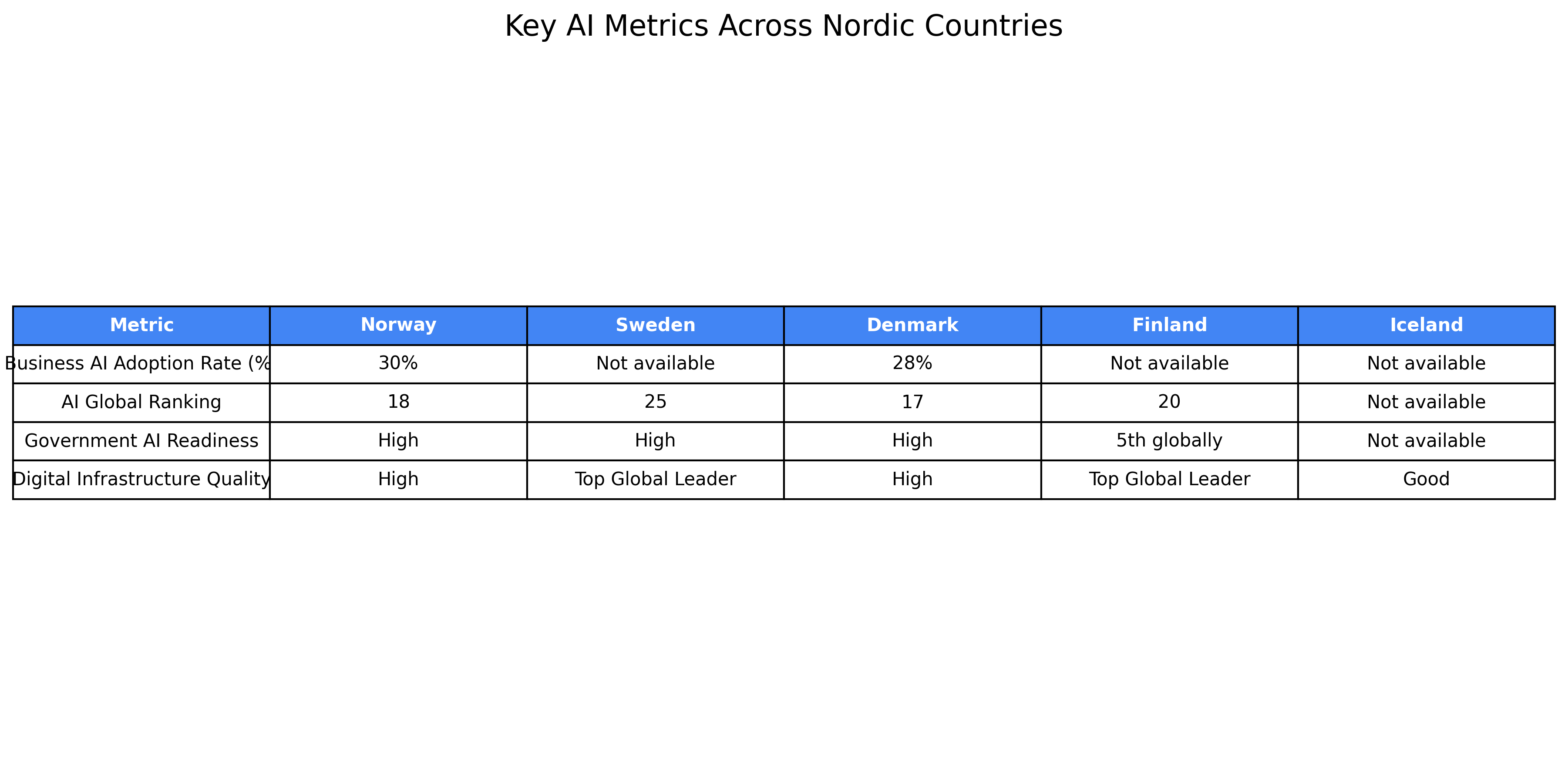
Key AI Metrics: Norway vs. Nordic Countries
Norway demonstrates competitive performance across several key metrics. In business AI adoption, Norway leads the Nordic countries with a 30% adoption rate, compared to Denmark's 28% (with data for Sweden and Finland not fully available). Both figures significantly exceed the EU average of 13.5%. In digital infrastructure quality, Norway is rated as 'High', providing a solid foundation for AI development, though not yet at the 'Top Global Leader' level achieved by Sweden and Finland.
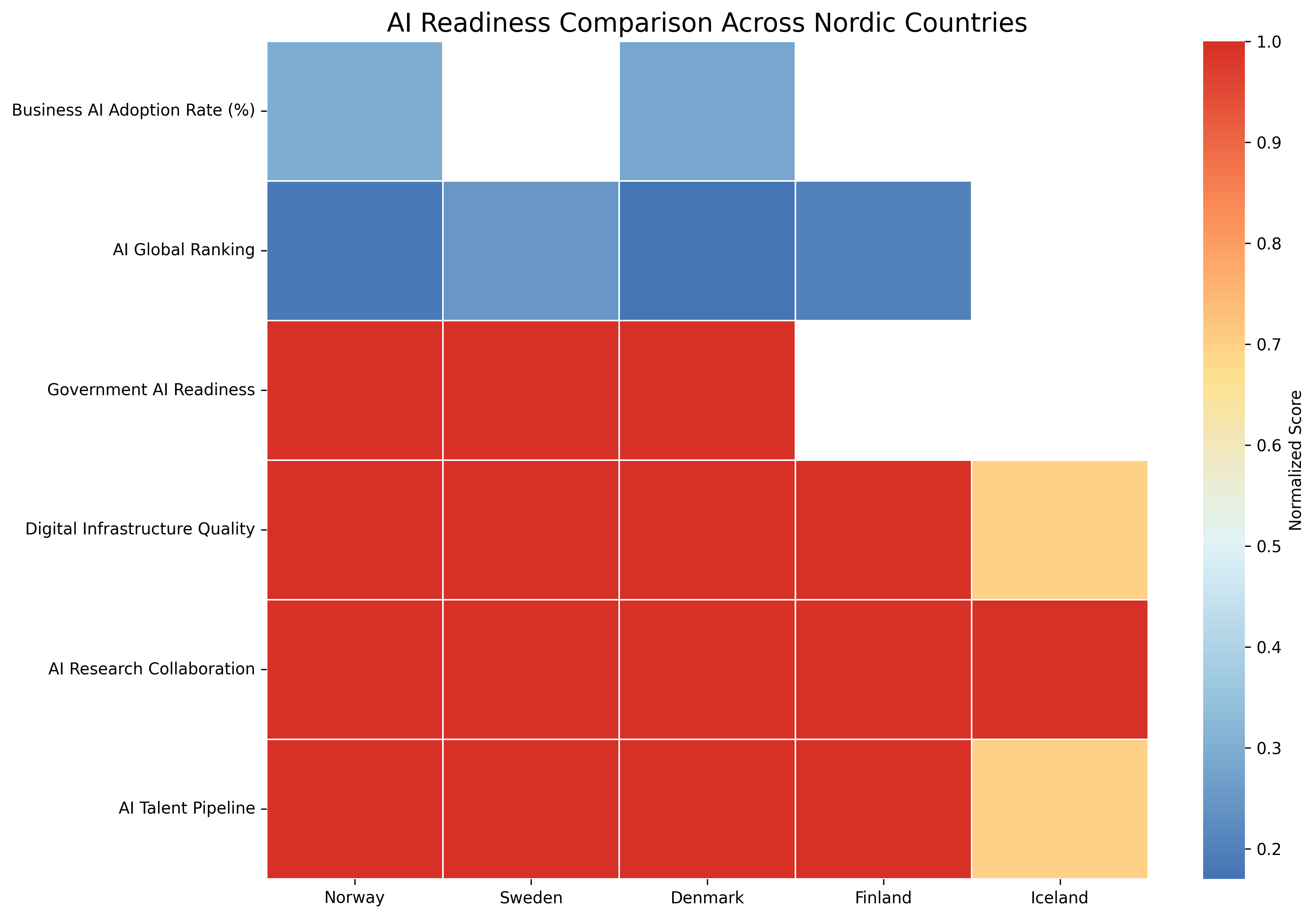
Nordic AI Readiness Heatmap
Rankings in International AI Indices
Norway holds a strong position in global AI readiness rankings, placing 10th worldwide according to the Government Artificial Intelligence Readiness Index. Notably, Norway ranks 2nd globally for responsible use of AI, demonstrating leadership in ethical AI implementation. In innovation specifically, Norway ranks 18th globally, ahead of Finland (20th) and Sweden (25th), but behind Denmark (17th).
Within the Nordic context, Norway is consistently among the top performers, though specific rankings vary by index and metric. Norway appears alongside other high-performing Northwestern European countries like Denmark (ranked 2nd globally), Finland (ranked 6th), and the Netherlands (ranked 4th).
Relative Position in the Nordic Region
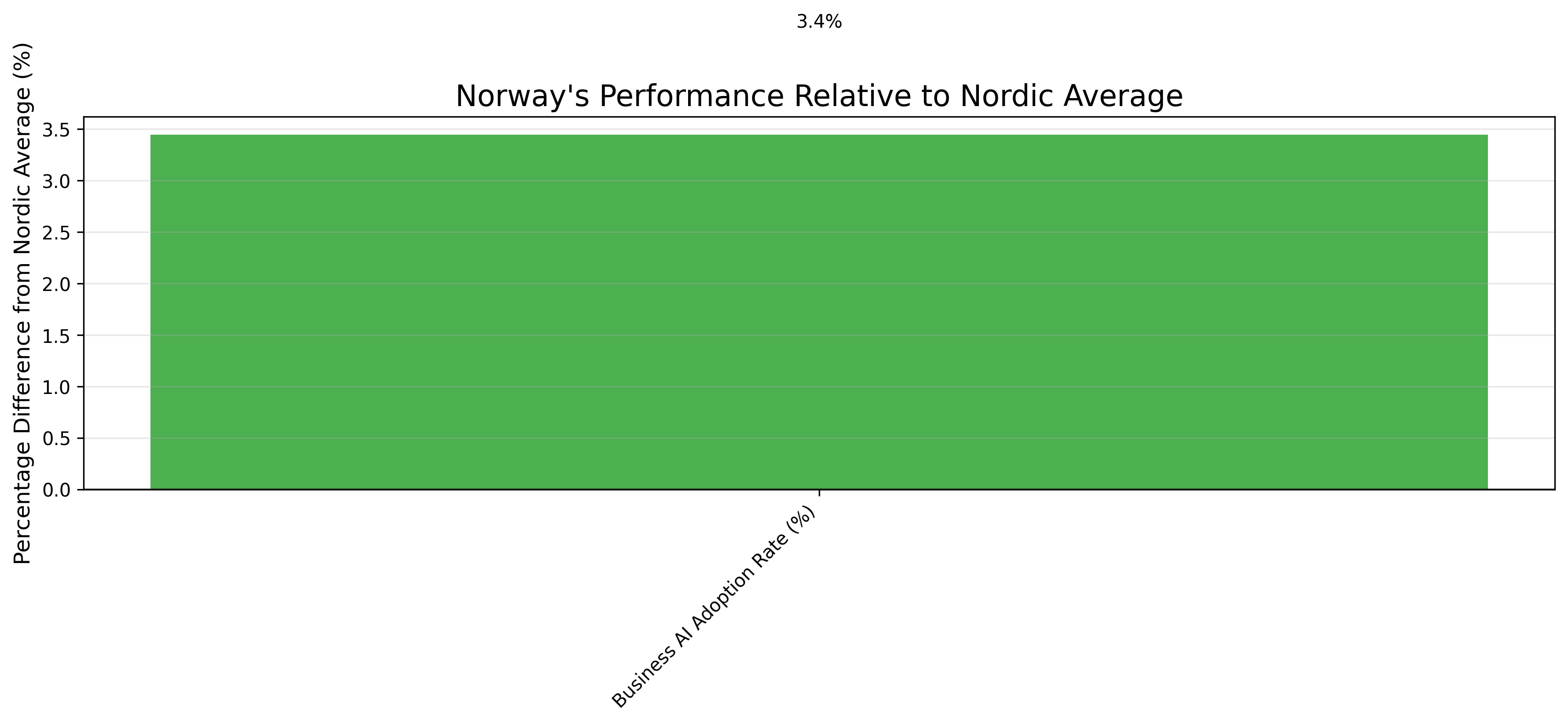
Norway's Performance Relative to Nordic Averages
Norway's position within the Nordic region is competitive but mixed. While leading in business AI adoption at 30% (compared to Denmark's 28%), Norway ranks 3rd among the five Nordic countries in overall AI readiness. Finland stands out with its 5th place global ranking in government AI readiness, while Sweden and Finland are both classified as 'Top Global Leaders' in digital infrastructure quality, compared to Norway's 'High' rating.
Strengths and Gaps Compared to EU Averages
Norway significantly outperforms EU averages in most measurable metrics. Business AI adoption in Norway (30%) is more than double the EU average (13.5%). The projected AI market size of US$1.41 billion by 2025 represents substantial investment relative to Norway's population and economy size. Norway's public sector AI adoption rate of 50% also appears to exceed typical EU levels, though direct comparative data is limited.
Trend Analysis
The trend data suggests Norway is on an upward trajectory in AI readiness and implementation. The establishment of new institutional structures (such as the Ministry of Digitalization and Public Governance in January 2024), increased funding commitments, and the planned establishment of 4-6 new AI research centers all indicate positive momentum. The machine learning market in Norway is projected to grow by 28% in 2024, suggesting accelerating adoption and investment. However, comparative trend data with other Nordic and EU countries is limited, making it difficult to assess whether Norway is gaining or losing ground relative to its peers.
Sectoral & Institutional Strengths
Norway demonstrates distinct strengths across various sectors and institutions in its AI ecosystem. These strengths form the foundation of the country's competitive positioning in the global AI landscape.
Public Sector AI Readiness and Adoption
The public sector represents one of Norway's most significant AI strengths, with an adoption rate of 50% and more than half of central government entities having integrated AI technologies. The establishment of the Ministry of Digitalization and Public Governance in January 2024 demonstrates institutional commitment to digital transformation. Norway's public sector AI strategy focuses on priority areas including health, public administration, and energy, with clear goals and implementation timelines extending to 2030.
Norway's government AI readiness is rated as 'High' in international comparisons, and the country ranks 10th globally in overall government AI readiness, with a particularly strong 2nd place ranking for responsible use of AI. This indicates a well-developed approach to ethical and effective AI implementation in government services and operations.
Private Sector Implementation and Investment
Norway's private sector shows strong AI engagement with a 30% business adoption rate, significantly above the EU average of 13.5% and higher than Denmark's 28%. The AI market in Norway is projected to reach US$1.41 billion by 2025, indicating substantial commercial activity and investment. Notable private sector investments include Vespa.ai ($31 million funding), Metric AI (€8 million), and various cybersecurity AI startups ($7 million collectively).
Specific industries show particularly high adoption rates, with 93% of marketers reportedly using AI tools like ChatGPT. The financial sector is also embracing AI transformation, as evidenced by Norway's sovereign wealth fund implementing AI solutions that have led to significant workforce optimization, with over 37% reduction in 2024 and expectations of 20% further reduction in 2025.
Academic and R&D Capabilities
Norway maintains active AI research collaboration through institutions like the Norwegian AI Research Consortium. The government's commitment to establish 4-6 new AI research centers by 2025, supported by NOK 850 million in funding (with each center receiving between NOK 75-200 million), demonstrates substantial investment in research infrastructure. Research focuses on strategic sectors including health, seas and oceans, public administration, and energy.
While specific metrics on research output are limited, the planned research centers and funding allocations suggest a strong foundation for future academic and R&D capabilities. The development of a national supercomputer to support AI research further strengthens Norway's research infrastructure.
Digital Infrastructure and Data Readiness
Norway's digital infrastructure quality is rated as 'High', providing a solid foundation for AI development. The country has set ambitious targets for digital infrastructure development, including providing minimum internet speeds of 100Mbps to all households and businesses by the end of 2025. Norway is described as a 'thoroughly digitalised society' with extensive digital transformation in recent years.
The current digital strategy, set to expire in 2025, emphasizes infrastructure as a foundation for digital transformation, with a focus on communication infrastructure, high-quality data, and sufficient computing power as critical enablers for AI adoption and exploitation. The development of a national supercomputer further strengthens Norway's data processing capabilities.
Talent and Workforce Development
Norway is investing heavily in tech skills, with a €90 million government investment in talent development. Currently, 28.2% of workers across sectors are exposed to generative AI technologies, indicating growing familiarity with AI tools in the workforce. The machine learning market in Norway is projected to grow by 28% in 2024, creating increased demand for specialized skills.
Organizations are prioritizing technological upskilling rather than expanding headcount, with major institutions like the Norway Wealth Fund focusing on AI capabilities over traditional hiring. This shift indicates a transformation in workforce development strategies, with increasing emphasis on AI-related skills and competencies.
Innovation and Commercialization Ecosystem
Norway's innovation ecosystem shows promising development, with the country ranking 18th globally in AI innovation, ahead of Finland (20th) and Sweden (25th), though behind Denmark (17th). With at least 19 AI startups in Oslo alone, Norway demonstrates a growing entrepreneurial ecosystem in the AI space.
Funding for AI startups shows positive momentum, with examples including Vespa.ai ($31 million), Metric AI (€8 million), cybersecurity AI startups ($7 million), and Factiverse ($1.45 million). These investments indicate a functioning commercialization pathway for AI innovations, though the ecosystem may not yet match the scale and maturity of larger European innovation hubs.
Challenges, Gaps & Risks
Despite Norway's strong positioning in many aspects of AI readiness, several challenges, gaps, and risks could impact the country's ability to achieve its ambitious AI goals. Identifying and addressing these issues will be crucial for maintaining and improving Norway's competitive position.
Identified Weaknesses in Norway's AI Ecosystem
While Norway shows strong overall AI readiness, its 3rd place ranking among the five Nordic countries indicates room for improvement relative to regional leaders. The country's digital infrastructure quality is rated as 'High' but has not yet reached the 'Top Global Leader' status achieved by Sweden and Finland, potentially limiting the deployment of the most advanced AI applications.
The disparity in AI adoption between larger enterprises and SMEs represents another significant weakness. While overall business adoption stands at 30%, small-sized Norwegian enterprises show much lower adoption rates of approximately 8%, indicating a potential digital divide that could limit the economic benefits of AI across the broader economy.
Regulatory and Ethical Challenges
Norway faces the complex task of implementing the proposed AI Act regulations in 2025, which will require balancing innovation with appropriate safeguards. While Norway ranks 2nd globally for responsible use of AI, the rapidly evolving nature of AI technologies presents ongoing challenges in maintaining ethical standards while fostering innovation.
Alignment with EU frameworks while maintaining Norway's specific priorities and approaches presents another regulatory challenge. As a non-EU member with close ties to the European market, Norway must navigate the complexity of harmonizing its AI regulations with EU standards while preserving policy autonomy.
Infrastructure Limitations
Despite strong digital infrastructure overall, Norway's position below Sweden and Finland in infrastructure quality rankings suggests potential limitations in supporting the most advanced AI applications. The ambitious target of providing minimum internet speeds of 100Mbps to all households and businesses by the end of 2025 acknowledges current gaps in connectivity that may affect AI deployment in remote regions.
The development of specialized AI computing infrastructure, including the planned national supercomputer, remains a work in progress. Ensuring sufficient computing power for advanced AI research and applications will require continued investment and development.
Talent Gaps and Educational Needs
Despite investments in tech skills development, Norway faces competition for specialized AI talent in a global market where demand significantly exceeds supply. The rapid growth of the machine learning market (projected at 28% in 2024) creates increasing demand for specialized skills that may outpace the development of the domestic talent pipeline.
The workforce transformation driven by AI adoption, as evidenced by significant reductions in traditional roles at institutions like Norway's sovereign wealth fund, creates challenges in reskilling and transitioning workers to new roles in the AI economy.
Competitive Threats from Other Countries
Norway faces strong competition from Nordic neighbors with established leadership in specific AI domains. Finland's 5th place global ranking in government AI readiness and Sweden's position as a 'Top Global Leader' in digital infrastructure quality represent benchmarks that Norway has yet to achieve.
Beyond the Nordic region, global AI powerhouses like the United States, China, and rapidly advancing EU members are investing heavily in AI capabilities, potentially limiting Norway's ability to achieve global leadership in specific AI domains despite its strong regional positioning.
Sector-Specific Adoption Barriers
The significant disparity between public sector adoption (50%) and overall business adoption (30%), particularly among SMEs (8%), indicates sector-specific barriers to AI implementation. These may include limited awareness, insufficient technical capabilities, concerns about return on investment, or challenges in integrating AI with existing systems and processes.
While Norway has identified priority sectors for AI development (Health, Seas and Oceans, Public Administration, Energy, and Mobility), achieving deep AI integration in traditional industries may present specific challenges related to legacy systems, regulatory requirements, and specialized domain knowledge.
Forecast: Norway's Path in Global AI
Looking ahead to the next 3-5 years, Norway's trajectory in the global AI landscape will be shaped by the interplay of its strategic investments, policy decisions, and ability to address identified challenges. This forecast examines potential scenarios for Norway's AI competitiveness through 2030.
3-5 Year Projection of Norway's AI Competitiveness
Based on current trends and investments, Norway is positioned to maintain and potentially improve its competitive standing in global AI readiness over the next 3-5 years. The establishment of 4-6 new AI research centers by 2025, backed by NOK 850 million in funding, will likely strengthen Norway's research capabilities and innovation output. The projected growth of Norway's AI market to US$1.41 billion by 2025, with continued expansion expected through 2031, indicates sustained commercial development.
Norway's global ranking in AI readiness (currently 10th) could improve to the top 5-7 countries by 2030 if current investments and policy initiatives are successfully implemented. Within the Nordic region, Norway has the potential to move from its current 3rd position to challenge for leadership, particularly in sectors aligned with its strategic priorities such as health, energy, and public administration.
Potential Accelerators for Growth
Several factors could accelerate Norway's AI development beyond current projections. The successful implementation of the planned AI research centers could create innovation clusters that attract international talent and investment. Norway's strong position in responsible AI use (ranked 2nd globally) could become an increasingly valuable differentiator as ethical considerations gain importance in global AI governance.
Norway's substantial financial resources, including its sovereign wealth fund, provide potential for increased AI investment beyond current commitments. Strategic deployment of these resources could accelerate both public and private sector AI adoption. Additionally, Norway's high digitalization levels and strong public sector adoption create a foundation for rapid scaling of successful AI implementations across government services and critical infrastructure.
Bottlenecks that May Impede Progress
Despite positive indicators, several bottlenecks could slow Norway's AI progress. The global competition for specialized AI talent may limit the availability of skilled professionals needed to implement ambitious AI initiatives. The significant gap in AI adoption between large enterprises and SMEs (30% versus 8%) could create a two-tier digital economy that limits overall economic benefits and innovation diffusion.
Regulatory complexity, particularly in harmonizing with EU frameworks while maintaining policy autonomy, could create uncertainty that slows private sector investment and adoption. Additionally, while Norway's digital infrastructure is strong, achieving the 'Top Global Leader' status of Sweden and Finland will require sustained investment and development to support the most advanced AI applications.
Recommendations for Maintaining/Improving Position
- Accelerate SME adoption through targeted support programs, reducing the current adoption gap between large enterprises and smaller businesses
- Develop specialized AI talent pipelines through educational initiatives and international recruitment strategies
- Ensure the planned AI research centers develop strong commercialization pathways to translate research into economic and social benefits
- Leverage Norway's strength in responsible AI to develop governance frameworks that enable innovation while maintaining ethical standards
- Upgrade digital infrastructure to achieve 'Top Global Leader' status, particularly in advanced computing capabilities for AI
- Deepen international collaboration, particularly within the Nordic region, to create economies of scale in AI research and development
Emerging Opportunities and Risks
Norway's strategic focus on specific sectors (Health, Seas and Oceans, Public Administration, Energy, and Mobility) aligns well with emerging opportunities in AI application. The country's strong position in energy, particularly its transition to renewable sources, creates opportunities for AI-optimized energy systems. Similarly, Norway's extensive maritime industries provide a natural testbed for AI applications in ocean management and maritime operations.
However, risks include potential disruption to traditional employment models, as evidenced by the Norway Wealth Fund's significant workforce reduction due to AI implementation. Managing this transition will require effective policies for workforce reskilling and economic adjustment. Additionally, as AI becomes increasingly critical to national competitiveness, Norway's relatively small size compared to major global powers could limit its ability to shape international AI standards and governance frameworks, potentially reducing its influence over the rules that will govern future AI development.
Sources, Assumptions, and Notes
This report draws on multiple data sources, each with specific methodologies and limitations. Understanding these factors is essential for interpreting the findings and recommendations presented.
Comprehensive List of Data Sources
- EU AI Watch: European Commission's knowledge service monitoring AI development and uptake in Europe
- Stanford AI Index 2025: Annual report tracking global AI development and adoption
- OECD AI Policy Observatory: Platform providing data and analysis on AI policy
- World Economic Forum: Various reports on global AI readiness
- European AI Investment Report 2024: Analysis of AI investment across European countries
- Norway National AI Strategy 2025: Norway's strategic plan for AI development
- Research Council of Norway: Data on AI research funding and initiatives
- Statistics Norway (SSB): Official statistics on technology adoption and digital economy
- Digital Norway: Information on Norway's digitalization strategy and initiatives
- Norwegian AI Research Consortium: Data on AI research activities and projections
Methodology Notes and Limitations
This report faces several methodological challenges common to comparative analyses of AI readiness. Different indices and reports use varying methodologies to measure AI readiness, making direct comparisons challenging. Some sources focus on government readiness, others on private sector or infrastructure, with examples including the Oxford Insights Government AI Readiness Index (40 indicators across 3 pillars) and the Global AI Index (122 indicators).
Adoption metrics vary significantly across sources, with some measuring adoption by percentage of businesses using AI, others focusing on specific use cases or technologies, and definitions of 'AI adoption' differing across sources. Investment tracking also varies, with some sources tracking only venture capital investment, others including government funding, corporate R&D, and academic research, creating challenges for comprehensive investment comparisons.
Assumptions Made During Analysis
- Where trend data was limited, we assumed continuation of current trajectories unless specific factors suggested otherwise
- For metrics where Norway-specific data was unavailable, we used Nordic or EU averages as proxies where appropriate
- We assumed that announced funding commitments and policy initiatives will be implemented as planned
- In comparing adoption rates across countries, we assumed broadly similar definitions of AI adoption despite potential methodological differences
- Projections assume relatively stable global economic and political conditions without major disruptions
Data Gaps and Areas for Further Research
Several important data gaps limit the comprehensiveness of this analysis. Detailed breakdowns of AI adoption rates by industry sector in Norway are not consistently available, making it difficult to identify sector-specific strengths and weaknesses beyond the aggregate level. Historical data for trend analysis is limited for many metrics, constraining our ability to project future trajectories with high confidence.
Specific metrics available for other countries are not always available for Norway, creating challenges for direct comparisons. Additionally, private sector data, particularly for SMEs and industry-specific adoption, is limited and often at an aggregate level rather than providing granular insights.
Further research is recommended in several areas: conducting primary research to fill specific data gaps for Norway; developing standardized metrics for comparing AI readiness across Nordic countries; investigating industry-specific AI adoption rates in Norway; tracking implementation progress of Norway's national AI strategy; and analyzing the impact of AI research centers once established.